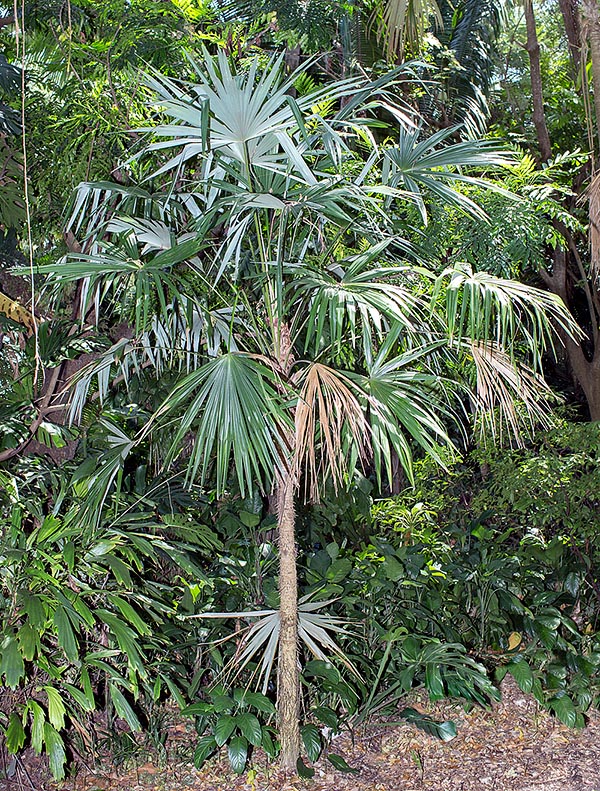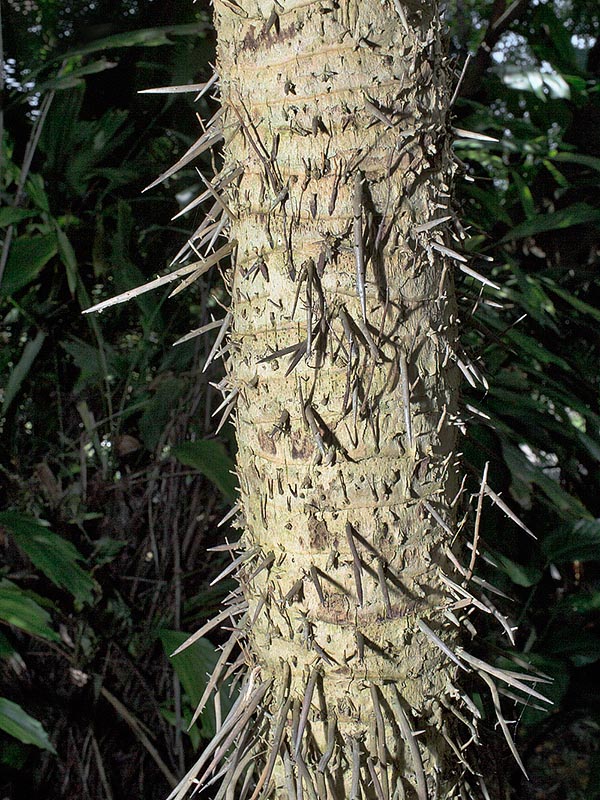Family : Arecaceae

Text © Pietro Puccio

English translation by Mario Beltramini

Native to the Central America rain forests, the Cryosophila stauracantha can be 9 m tall © Giuseppe Mazza
The name of the genus is the combination of the Greek substantive “κρύος” (cryos) = frost, cold and “φίλος” (philos) = friend, maybe with reference to the type species, the Cryosophila nana (Kunth) Blume ex Salomon (1887), that lives in Mexico up to about 1700 m of altitude; the name of the species is the combination of the Greek substantives “σταυρός” (stauros) = pole and ἄκανθα” (acantha) = thorn, with reference to the long roots similar to spines that appear along the stem.
Common names: rootspine palm, silver rootspine palm (English); give-and-take palm (Belize); escoba, palo de escoba, guano kurn, kuano k’uum (Guatemala and Mexico).
The Cryosophila stauracantha (Heynh.) R.J.Evans (1995) is a monoecious species with solitary stem, erect, up to about 9 m tall and of 6-12 cm of diameter, greyish, covered by thorny adventitious roots, ramified, usually bent downwards, that at the base root forming a sort of a support cone up to 30 cm tall.
The leaves, on an up to1,8 m long unarmed petiole, are palmate, almost circular, of about 1,8 m of diameter, deeply divided in numerous segments united in groups of 2-4, of dark green colour above, whitish grey below.
Ramified drooping inflorescences, 50-90 cm long, originate among the leaves (interfoliar) with each ramification enclosed by a deciduous concave bract tomentose and whitish externally, the apical ones are united at the apex and at the time of blooming detach and fall together.
Whitish hermaphroditic flowers. The fruits are globose-pyriform of 1,2-1,4 cm of diameter, of white colour and containing one single seed.

The trunk has thorny adventitious roots that expand conically towards the base and root on the soil with support function. Crushed leaves ease fishing. The pulp of petioles is haemostatic, lenitive and disinfectant © Giuseppe Mazza
Species of remarkable ornamental characteristics due to the thin spiny stems and the leaves in which the lower silvery white page contrasts with the dark green of the upper one, utilizable in parks and gardens of the tropical, subtropical climate regions as well as in milder warm temperate ones, where temperatures around the 0 °C are exceptional events and very short lasting, taking care to position it far from the passing by places.
It requires a partially shady position, in particular during the juvenile phase of growth, and draining soils, slightly alkaline to alkaline, rich of organic substance and maintained constantly humid.
The stems are used by the local populations in the constructions and the leaves as cover of makeshift shelters; with the young leaves, dried up and tied together, they fabricate brooms. The crushed leaves immersed in water have a temporary paralyzing effect on the fishes, thus facilitating their seizure.
The Belize common name, give-and-take, refers to the thorns that may cause serious wounds, whilst the inner part of the petioles and of the foliar base, fibrous and sticky, applied on the wounds, is deemed to have a haemostatic, lenitive and disinfectant action.
Synonyms: Chamaerops stauracantha Heynh. (1845); Acanthorrhiza stauracantha (Heynh.) H.Wendl. ex Linden (1871); Cryosophila argentea Bartlett (1935); Acanthorrhiza collinsii O.F.Cook (1941); Cryosophila bifurcata Lundell (1945).
→ For general notions about ARECACEAE please click here.
